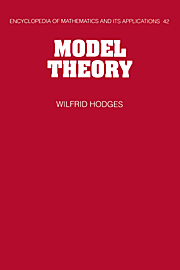Book contents
- Frontmatter
- Contents
- Introduction
- Note on notation
- 1 Naming of parts
- 2 Classifying structures
- 3 Structures that look alike
- 4 Automorphisms
- 5 Interpretations
- 6 The first-order case: compactness
- 7 The countable case
- 8 The existential case
- 9 The Horn case: products
- 10 Saturation
- 11 Combinatorics
- 12 Expansions and categoricity
- Appendix: Examples
- References
- Index to symbols
- Index
2 - Classifying structures
Published online by Cambridge University Press: 08 October 2009
- Frontmatter
- Contents
- Introduction
- Note on notation
- 1 Naming of parts
- 2 Classifying structures
- 3 Structures that look alike
- 4 Automorphisms
- 5 Interpretations
- 6 The first-order case: compactness
- 7 The countable case
- 8 The existential case
- 9 The Horn case: products
- 10 Saturation
- 11 Combinatorics
- 12 Expansions and categoricity
- Appendix: Examples
- References
- Index to symbols
- Index
Summary
I must get into this stone world now.
Ratchel, striae, relationships of tesserae,
Innumerable shades of grey …
I try them with the old Norn words – hraun
Duss, r∅nis, queedaruns, kollyarum …
Hugh MacDiarmid, On a raised beach.Now that we have structures in front of us, the most pressing need is to start classifying them and their features. Classifying is a kind of defining. Most mathematical classification is by axioms or defining equations – in short, by formulas. This chapter could have been entitled ‘The elementary theory of mathematical classification by formulas’.
Notice three ways in which mathematicians use formulas. First, a mathematician writes the equation ‘y = 4x2’. By writing this equation one names a set of points in the plane, i.e. a set of ordered pairs of real numbers. As a model theorist would put it, the equation defines a 2-ary relation on the reals. We study this kind of definition in section 2.1.
Or second, a mathematician writes down the laws
(*) For all x, y and z, x ≤y and y ≤ z imply x ≤ z;
for all x and y, exactly one of x≤y,y≤x,x = y holds.
By doing this one names a class of relations, namely those relations ≤ for which (*) is true. Section 2.2 lists some more examples of this kind of naming. They cover most branches of algebra.
- Type
- Chapter
- Information
- Model Theory , pp. 23 - 86Publisher: Cambridge University PressPrint publication year: 1993



